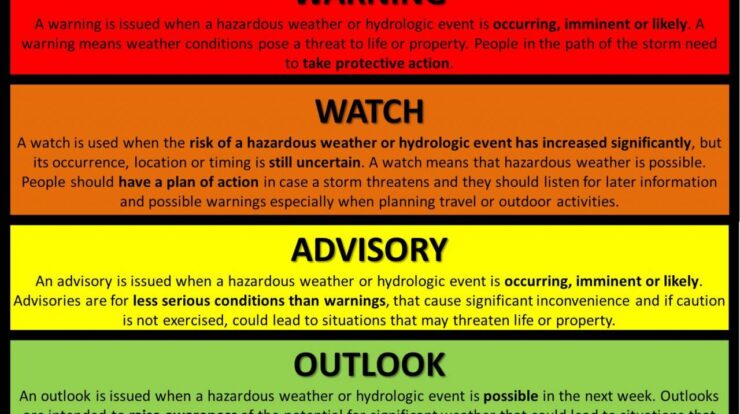
Difference between watch and warning – When it comes to severe weather, understanding the difference between watches and warnings is crucial for effective preparedness and response. Watches and warnings are distinct weather alerts issued by meteorological agencies to inform the public of potential or impending hazardous weather conditions, and knowing their specific meanings can save lives.
Watches indicate the possibility of severe weather developing within a certain timeframe, typically 12 to 48 hours. Warnings, on the other hand, are issued when severe weather is imminent or already occurring and immediate action is required to protect life and property.
Definition and Purpose

In weather forecasting, a watch and a warning serve distinct roles in communicating potential and impending weather hazards. A watch indicates the possibility of a specific weather event occurring within a certain timeframe, typically within the next 12 to 48 hours.
It alerts people to be prepared and monitor weather conditions closely.
Whether you’re a sports enthusiast glued to the Lakers watch or an avid nature lover tuning into an Amazon watch party , there’s something for everyone to enjoy. But when it comes to weather warnings, it’s important to know the difference between a watch and a warning.
A watch means conditions are favorable for severe weather, while a warning indicates that severe weather is imminent or already occurring. Stay informed by checking the latest watch or warning updates.
A warning, on the other hand, signifies that the hazardous weather event is imminent or already occurring. It is issued when the event is expected to impact an area within the next few hours or minutes. Warnings prompt immediate action to protect life and property.
Issuance Criteria
The issuance of a watch or warning is based on specific criteria established by weather forecasting agencies. A watch is typically issued when weather models predict that conditions favorable for a particular weather event are developing or likely to develop.
A warning is issued when weather radar or observations indicate that the hazardous weather event is either occurring or is expected to occur with a high degree of certainty within a short period.
Level of Severity
Watches and warnings are assigned different levels of severity based on the potential impact of the forecasted weather event. Watches typically indicate a lower level of severity, suggesting that the event is possible but not yet imminent.
Warnings, however, convey a higher level of severity, indicating that the event is either already occurring or is expected to occur with significant impact. Warnings urge people to take immediate protective actions.
For those looking to catch up on the latest political news, the white house correspondents dinner watch is a must-see. This annual event brings together journalists, politicians, and celebrities for a night of entertainment and political commentary. Whether you’re interested in the latest Amazon watch party or the upcoming election, there’s something for everyone to enjoy in the world of live streaming.
Lead Time and Response
Watches provide a longer lead time compared to warnings. They give people time to prepare and make necessary arrangements before the weather event occurs. The lead time can range from several hours to a few days.
Warnings, on the other hand, have a shorter lead time. They are issued when the hazardous weather event is imminent or already occurring, providing limited time for response. People should take immediate action to protect themselves and their property.
Dissemination and Communication, Difference between watch and warning
Watches and warnings are disseminated through various channels to reach the public. Weather forecasting agencies issue these alerts through official websites, social media, and mobile applications.
The media plays a crucial role in disseminating watches and warnings to a wider audience. Emergency management agencies and local authorities also work to ensure timely and effective communication of these alerts to communities.
Comparison Table
| Definition | Purpose | Criteria | Severity | Lead Time | Response | |
|---|---|---|---|---|---|---|
| Watch | Indicates the possibility of a weather event | Alert people to be prepared | Favorable conditions for event | Lower | Several hours to days | Prepare and monitor conditions |
| Warning | Imminent or ongoing hazardous weather event | Prompt immediate action | Event is occurring or expected soon | Higher | Minutes to hours | Take immediate protective actions |
Last Word
Comprehending the difference between watches and warnings empowers individuals and communities to make informed decisions during severe weather events. By staying informed and taking appropriate actions based on these alerts, we can enhance our safety and resilience in the face of potentially dangerous weather conditions.
Quick FAQs: Difference Between Watch And Warning
What is the key difference between a watch and a warning?
Watches indicate the potential for severe weather within a specific timeframe, while warnings are issued when severe weather is imminent or already occurring.
What should I do when a watch is issued?
Monitor weather updates and be prepared to take action if a warning is issued or if conditions worsen.
What should I do when a warning is issued?
Take immediate action to protect yourself and your property, such as seeking shelter or evacuating if necessary.